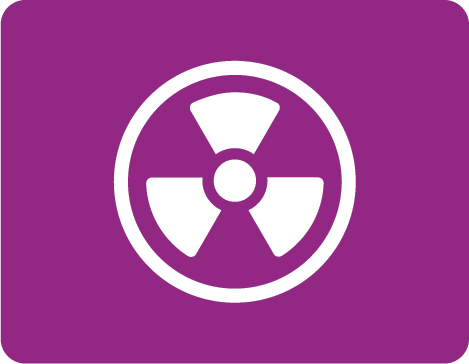 Radioactive substances
Radioactive substances
2 Relevance of the indicator
The development and use of nuclear power for military and peaceful purposes has resulted in the production of a number of man-made radioactive substances and various levels of their release into the environment. For instance, even the routine operations of nuclear power plants cause small controlled discharges of radioactive substances. Not to mention, accidents at nuclear power plants may release considerable amounts of radioactivity into the environment. Artificial radionuclides of particular concern to humankind and the environment, including 137Cs, are formed by nuclear fission.
The radionuclide caesium-137 (137Cs) is the greatest contributor to the level of artificial radionuclides in the Baltic Sea, where the level of 137Cs contamination is still higher than in any other ocean of the world. This high level of 137Cs observed in the region originates from the accident at the Chernobyl nuclear power plant in 1986. The 137Cs radionuclide was introduced into the Baltic Sea water by atmospheric deposition and, to a lesser extent, through riverine input. This 137Cs radionuclide was and still is bioaccumulated in marine flora and fauna and may be deposited in marine sediments. Therefore, 137Cs activity concentrations are the key factor in assessing the radiological hazard to both marine organisms and humans (Nielsen et al. 1999), which are highly interconnected as the dominating exposure pathway of humans from man-made radioactivity in the Baltic Sea is related to the ingestion of 137Cs accumulated in fish.
2.1 Ecological relevance
A worldwide study on marine radioactivity has shown that the Baltic Sea has the highest average of 137Cs levels in surface water compared to other marine areas of the world (IAEA 2005). It is important to notice that levels of radionuclides in marine biota are directly linked to the corresponding levels in seawater and sediments via accumulation through food chains. Anthropogenic radionuclides, including 137Cs, entering seawater can be bioaccumulated and/or adsorbed via suspended particulate matter (composed mainly of plankton and mineral particles), which subsequently also accumulates in bottom sediments.
Radionuclides are also accumulated by higher organisms. The complexity of food chains increases together with the higher trophic level of the species considered, as the accumulation of radionuclides in fish are mainly linked to their food sources, and only negligibly from water. Predators such as cod and pike have shown the highest 137Cs levels, but there was some delay in reaching their maximum values after 1986, as compared to the trends in seawater. Nonetheless, in the long-term, 137Cs time trends in biota closely follow the trends in seawater (Zalewska and Suplińska 2013).
The harmful effects of 137Cs on marine organisms are related to the emission of ionising radiation, which can lead to internal damage, i.e. the effects are observed at the cellular level. Especially in the presence of other hazardous substances, the effects of radionuclides could be intensified (synergetic effects). Therefore, it is difficult to establish unequivocally which 137Cs concentrations can be considered harmless when we address species or ecosystem impacts because of the complexity of reactions of individual organisms to its effects. The effects of 137Cs on animal and human health are estimated by the approach of ICRP 2008.
Ingestion of 137Cs with fish is the dominating exposure pathway of humans to man-made radioactivity in the Baltic Sea. Therefore, 137Cs concentrations in herring (Clupea harengus) and in flatfish (flounder – Platichthys flesus – and plaice – Pleuronectes platessa) are suitable as indicators for man-made radioactivity in the Baltic Sea. Internationally recommended maximal permitted concentrations of 137Cs in foodstuff are in the range from 100 to 1250 Bq kg-1 (European Commission 2010a, 2012).
2.2 Policy relevance
The core indicator on caesium-137 in fish and surface waters addresses the Baltic Sea Action Plan’s (HELCOM BSAP 2021) hazardous substances segment’s ecological objective ‘Minimal risk to humans and the environment from radioactivity’.
The HELCOM Expert Group on Monitoring of Radioactive Substances in the Baltic Sea (MORS) has been working to implement the Helsinki Convention on matters related to the monitoring and evaluation of radioactive substances in the Baltic Sea based on HELCOM Recommendation 26/3 Monitoring of Radioactive Substances.
This core indicator also addresses the following qualitative descriptors of the Marine Strategy Framework Directive (MSFD) for determining Good Environmental Status (GES) (European Commission 2008):
- Descriptor 8: ‘Concentrations of contaminants are at levels not giving rise to pollution effects and
- Descriptor 9: ‘Contaminants in fish and other seafood for human consumption do not exceed levels established by Community legislation or other relevant standards
and the following criteria of the Commission Decision (European Commission 2010b):
- Criterion D8C1: ‘Within coastal, territorial and areas beyond territorial waters the concentrations of contaminants do not exceed the threshold values
- Criterion D9C1: ‘The level of contaminants in edible tissues of seafood caught or harvested in the wild does not exceed maximum levels which are the threshold values.
This core indicator also supports the implementation of the European Community of Atomic Energy (EAEC or Euratom) Treaty, of which all EU Member States are signatories. The Euratom Treaty requires actions in relation to monitoring and effects of discharges on neighbouring states.
Table 1. Policy relevance of the indicator.
| Baltic Sea Action Plan (BSAP) | Marine Strategy Framework Directive (MSFD) | |
| Fundamental link | Segment: Hazardous substances and litter
Goal: Baltic Sea unaffected by hazardous substances and litter
|
Descriptor 8 Concentrations of contaminants are at levels not giving rise to pollution effects.
(a) for contaminants set out under point 1(a) of criteria elements, the values set in accordance with Directive 2000/60/EC; (b) when contaminants under point (a) are measured in a matrix for which no value is set under Directive 2000/60/EC, the concentration of those contaminants in that matrix established by Member States through regional or subregional cooperation; (c) for additional contaminants selected under point 1(b) of criteria elements, the concentrations for a specified matrix (water, sediment or biota) which may give rise to pollution effects. Member States shall establish these concentrations through regional or subregional cooperation, considering their application within and beyond coastal and territorial waters. Beyond territorial waters, the concentrations of contaminants do not exceed the following threshold values: (a) for contaminants selected under point 2(a) of criteria elements, the values as applicable within coastal and territorial waters; (b) for contaminants selected under point 2(b) of criteria elements, the concentrations for a specified matrix (water, sediment or biota) which may give rise to pollution effects. Member States shall establish these concentrations through regional or subregional cooperation.
|
| Complementary link | Segment: Biodiversity
Goal: “Baltic Sea ecosystem is healthy and resilient”
|
Descriptor 9 Contaminants in fish and other seafood for human consumption do not exceed levels established by Union legislation or other relevant standards.
Criteria 1 The level of contaminants in edible tissues (muscle, liver, roe, flesh or other soft parts, as appropriate) of seafood (including fish, crustaceans, molluscs, echinoderms, seaweed and other marine plants) caught or harvested in the wild (excluding finfish from mariculture) does not exceed: (a) for contaminants listed in Regulation (EC) No 1881/2006, the maximum levels laid down in that Regulation, which are the threshold values for the purposes of this Decision; (b) for additional contaminants, not listed in Regulation (EC) No 1881/2006, threshold values, which Member States shall establish through regional or subregional cooperation.
|
| Other relevant legislation: |
|
|
2.3 Relevance for other assessments
In addition to providing an indicator-based evaluation of the status of radioactive substances in the Baltic Sea, this indicator also contributes to the overall integrated hazardous substances assessment. The contamination by hazardous substances is evaluated using several core indicators in the assessment of the status of the Baltic Sea marine environment. Each indicator focuses on one important aspect of the complex issue and the integrated assessment is the focus of the State of the Baltic Sea (HOLAS) Thematic Assessment on Hazardous Substances/Pollution.
3 Threshold values
Good status is achieved when the activity concentration levels of the radionuclide 137Cs are below 20 Bq kg-1 ww in fish (herring and flat fish) and below 40 Bq m-3 in seawater (Table 2 and Figure 2). Furthermore, target values exist of: 2.5 Bq kg-1 ww in case of herring, 2.9 Bq kg-1 ww in the case of the flatfish-group (flounder and plaice) and 15 Bq m-3 in case of seawater, which correspond to pre-Chernobyl activity levels, in other words levels before 1986.
Table 2. Good status is achieved when the activity concentration levels of the radionuclide caesium-137 (137Cs) are below the threshold value. The target values, i.e. at pre-Chernobyl level, are also described in the table.
| Threshold values | Target values | |
| Herring | 20 Bq kg-1 ww | 2.5 Bq kg-1 ww |
| Flatfish (flounder and plaice) | 20 Bq kg-1 ww | 2.9 Bq kg-1 ww |
| Seawater | 40 Bq m-3 | 15 Bq m-3 |
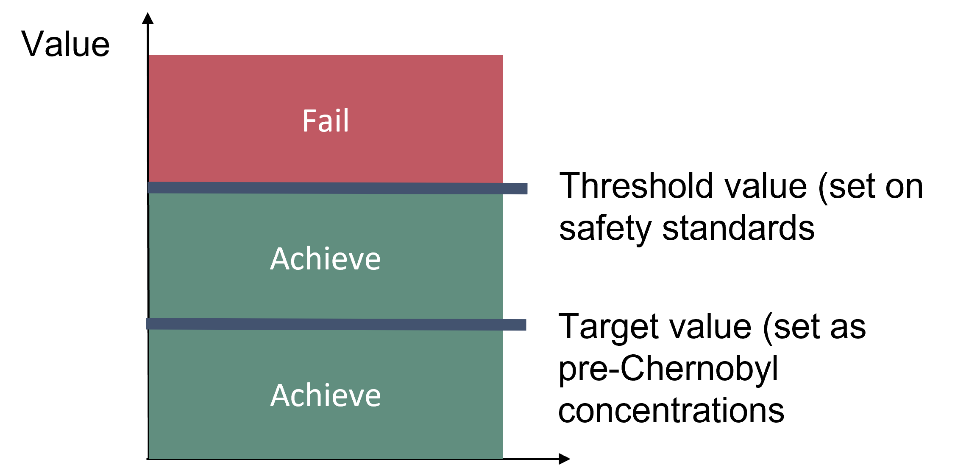
Figure 2. Schematic representation of threshold values and target values applied in this indicator.
The activity concentration of the radionuclide 137Cs is evaluated in herring, flatfish and seawater and compared against the threshold values.
Threshold values are uniform across all assessment units.
3.1 Setting the threshold value(s)
Due to the accident at the Chernobyl power plant on 26th of April 1986, significant amounts of radioactive isotopes reached the Baltic Sea as fallout. As a result, combined with the limited water exchange with the North Sea due to its semi-enclosed geography, this is currently one of the most contaminated waterbodies worldwide. The radioactive anthropogenic 137Cs isotope, with a relatively long half-life of 30 years, was selected as a core indicator of radioactivity levels in the Baltic Sea. Its activities in fish and seawater were used for the evaluation and reflect the changes in the environment. Additionally, three of the most common and commercially exploited fish species were selected for the evaluation of this indicator, namely herring and the flatfish group (plaice and flounder).
In connection with the revision of the main goals of the Baltic Sea Action Plan (BSAP), the Expert Group on Monitoring of Radioactive Substances in the Baltic Sea (MORS EG) rephrased the primary BSAP ecological objective of “Radioactivity at pre-Chernobyl levels” with the following formulation (HELCOM MORS EG 9-2019): “Minimal risk to humans and the environment from radioactivity”. The proposed change forces the necessity to adapt the threshold values for the established indicator (137Cs concentration in fish and seawater) to reflect the current best available knowledge and to base it on safety standards which refer to human safety related to fish consumption. Furthermore, the new ecological objective shall also fulfil the requirements of the Marine Strategy Framework Directive regarding assessments in terms of both: (i) Descriptor 8 (Concentrations of contaminants are at levels not giving rise to pollution effects) and (ii) Descriptor 9 (Contaminants in fish and other seafood for human consumption do not exceed levels established by Community legislation or other relevant standards).
The essential requirement to the threshold values for seawater and fish was that it must reflect the potential human exposure related to the consumption of fish from the Baltic Sea region, the potential human exposure from contact with contaminated water, and the potential threats to marine organisms. In order to do so, the following step-wise procedure was carried out:
- Determination of threshold value proposals for the protection of humans due to exposure from the consumption of selected fish species (based directly on safety standards),
- Determination of threshold value proposals for protecting humans from exposure due to contaminated seawater, adopting the same safety standards and based on actual data including exposure from internal and external sources (seawater and sediment),
- Recommendation of a set of human safety values as new threshold value proposals for fish (herring and flatfish) protection,
- Verification of the new threshold values by checking whether the doses derived from the proposed threshold values meet the criteria for protection of fauna and flora, which, according to ICRP 2008, is equal to the lower value of the ‘derived consideration reference levels ‘(DCRL), which is equal to 40 μGy h-1.
The starting point was the adoption of the value for radiological reference criteria for the protection of the public and the environment, which results from the current legislation. According to the recommendations from the European Commission (EC 2013), International Basic Safety Standards for Protection Against Ionizing Radiation and for the Safety of Radiation Sources (IAEA 2014) and the International Commission on Radiological Protection (ICRP 2008, 2012), three values of radiological reference criteria for human and non-human biota were considered within the process:
-
- the derived consideration reference levels (DCRL) to flora and fauna of 40 μGy h-1 (ICRP 2008),
- the established annual dose limit (1 mSv) for members of the public in planned exposure situations (EC 2013, IAEA 2014),
- the individual annual dose level (of the order of 10 μSv) used to grant exemption to activities and facilities (EC 2013, IAEA 2014).
Exposures related to human consumption of fish and human exposure to contaminated seawater were based on the procedures of IAEA 2015.
The calculations of new threshold values adopt the most preventive approach and use the annual threshold dose of 10 μSv from artificial radionuclides, which is an effective dose to members of the public. The basic calculations for estimating the new threshold value in fish related to the internal exposure to humans from seafood consumption uses: (i) the dose criterion of 10 μSv per year, (ii) the maximum annual fish intake of inhabitants of the Baltic Sea neighbouring states according to Guillen et al. (2019) and the generic value for modelling of IAEA 2001. For calculating a threshold value for 137Cs in seawater, dose rates from exposure scenarios to humans as outlined in IAEA 2015 were assumed. The scenario included external exposure from contaminated sediment, internal exposure from ingestion of beach sediment, and inhalation of sea spray as well as beach sediment.
The values determined by using the methods described above were respectively: 28.3 Bq kg-1 w.w. for fish and 47.2 Bq m-3 for seawater (HELCOM MORS EG 11-2021, Document 6-1). To verify the effectiveness of fish protection, the doses to fish from internal and external exposure arising from the new threshold concentrations were calculated. These need to be equal to or smaller than the lowest value of the ‘derived consideration reference levels’ (DCRL), which is 40 μGy h-1 (ICRP, 2008). The total doses to flatfish (4.82 ∙ 10‑3 μGy h-1) and herring (5.10 ∙ 10-3 μGy h-1) are far below the value of the ‘derived consideration reference levels’ (DCRL), which is equal to 40 μGy h-1. That means that the proposed threshold values for fish and seawater meet the requirements for protecting fish in the Baltic Sea environment.
Finally, taking into account the precautionary principle and using values rounded down to the lower ‘ten’ (i.e. 47 to 40), the new threshold values for the protection of humans and the environment were adopted as 40 Bq m–³ for seawater, and 20 Bq kg-1 w.w. for fish (HOD 61-2021), which meet the requirements specified by BSAP and MSFD at the same time.
4 Results and discussion
The results of the indicator evaluation that underly the key message map and information are provided below.
4.1 Status evaluation
The current evaluation of whether good status is achieved, using the concentrations of 137Cs in biota and seawater, is based on data from the assessment period 2016-2021. The results indicate that the activity concentrations of 137Cs in biota and seawater reflect good status in all evaluated HELCOM assessment units , with the exception of Gulf of Riga that was not evaluated due to a lack of available and suitable data. The observed values for herring, flatfish and seawater are further presented per HELCOM sub-basin in Figures 4-6 below. When evaluated together (i.e. a One-Out-All-Out. OOAO, approach between different parameters per sub-basin) to define overall status all evaluated areas achieve the threshold value and are thus in Good Environmental Status (Figure 3).
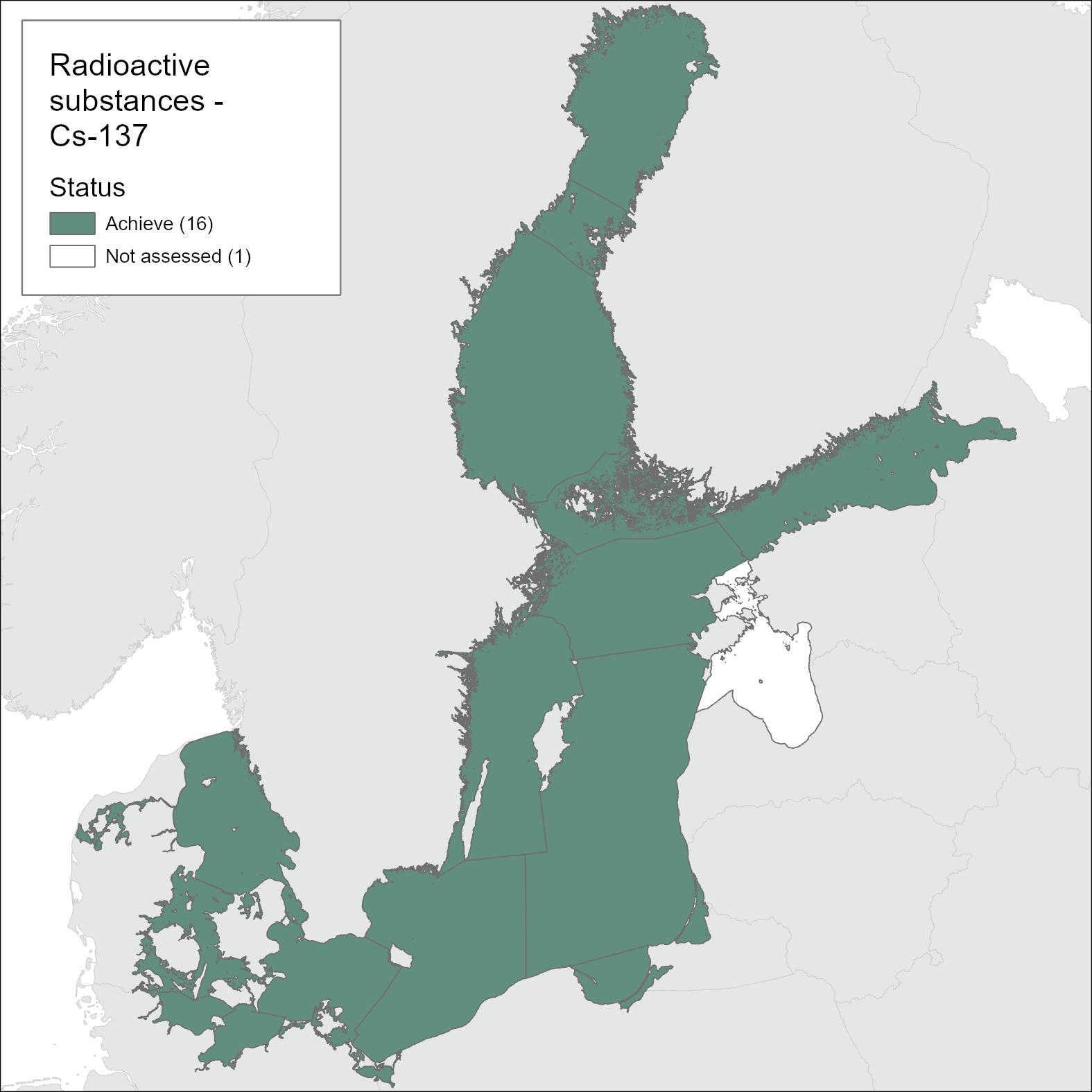
Figure 3. 137Cs status evaluation based on the One-Out-All-Out (OOAO) approach between different parameters (i.e. fish and water) per sub-basin.
Herring
Based on the data from the assessment period 2016 to 2021, good status for 137Cs in herring (Clupea harengus) was achieved in all of the HELCOM sub-basins, and in some cases the 137Cs activity concentration was even under the target value (pre-Chernobyl levels). The latter is the case for Arkona Basin, where the average concentration of 137Cs (calculated for the whole evaluated period) is equal to 1.6 Bq kg-1 wet weight, and for the sub-basins to the west of the Arkona Sea (Kiel Bay – 1.4 Bq kg-1 ww, and Kattegat – 0.6 Bq kg-1 ww). In the Gulf of Finland, the Gdańsk Basin, the Eastern and Western Gotland Basins, the Bornholm Basin and the Åland Sea, the average concentrations calculated for the period 2016-2021 were in the range from 2.6 to 3.7 Bq kg-1 ww, while the highest mean value was found in the Bothnian Bay – 4.0 Bq kg‑1 ww.
The annual mean values of concentrations of 137Cs in herring tissues in each sub-basin since 2000 are below the threshold value, showing a steady downward trend (Figure 4). In 2020 and 2021, in the areas of Åland Sea, Eastern Gotland Basin, Gdańsk Basin and Kattegat, the annual mean values were below the target value of 2.5 Bq kg-1 ww. In the remaining areas, some of the concentrations of 137Cs were higher, with the highest value slightly exceeding the 3 Bq kg-1 ww.

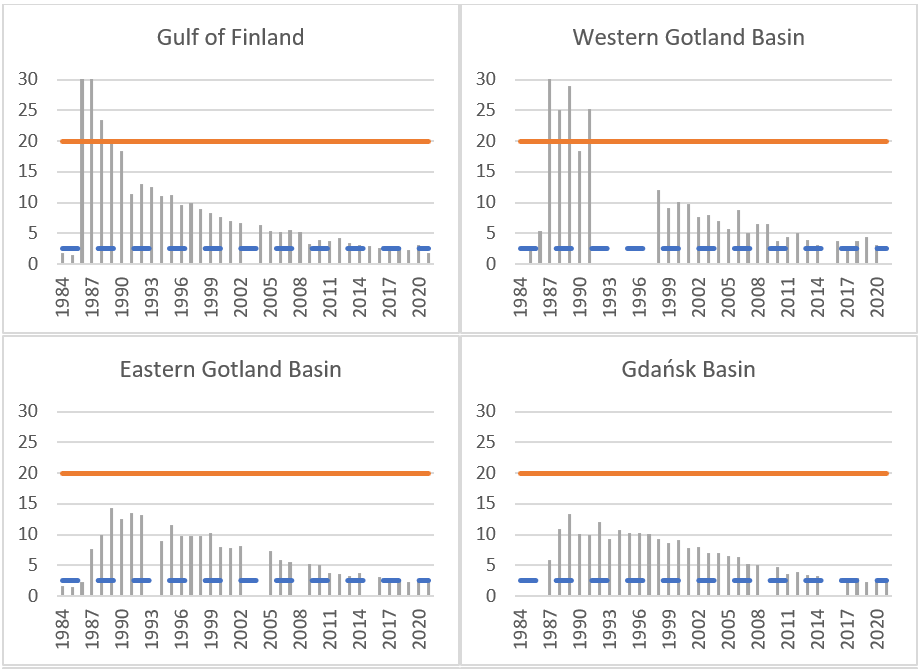

Figure 4. 137Cs mean concentrations (in Bq kg-1 wet weight) in herring (whole fish without head and entrails or flesh without bones) in 1984–2021, as annual mean by sub-basin. The good status boundary: threshold value for fish is equal to 20 Bq kg-1 ww – red line; target value is equal to 2.5 Bq kg-1 ww – blue line. Note the threshold value is not shown in the Arkona Basin and Kattegat figures due to the scale.
Flatfish
Based on data from the assessment period 2016-2021 for flatfish (plaice and flounder), good status was achieved in all HELCOM subbasins evaluated, with averages between 0.3 Bq kg-1 ww (Kattegat) and 3.25 Bq kg-1 ww (Eastern Gotland Basin).
Time series of 137Cs concentrations in flatfish samples (whole fish without head and entrails, or flesh without bones), which include flounder (Platichthys flesus) and plaice (Pleuronectes platessa) are shown in Figure 5. In 2021, the mean values of 137Cs concentrations were below target value 2.9 Bq kg-1 wet weight in three basins. They were at the levels of 0.1 Bq kg-1 ww in the Kattegat, 2.5 Bq kg-1 ww in Gdańsk Basin and 2.6 Bq kg-1 ww in Bornholm Basin. Only at the Eastern Gotland Basin (3.0 Bq kg-1 wet weight) the concentration exceeded the target value.

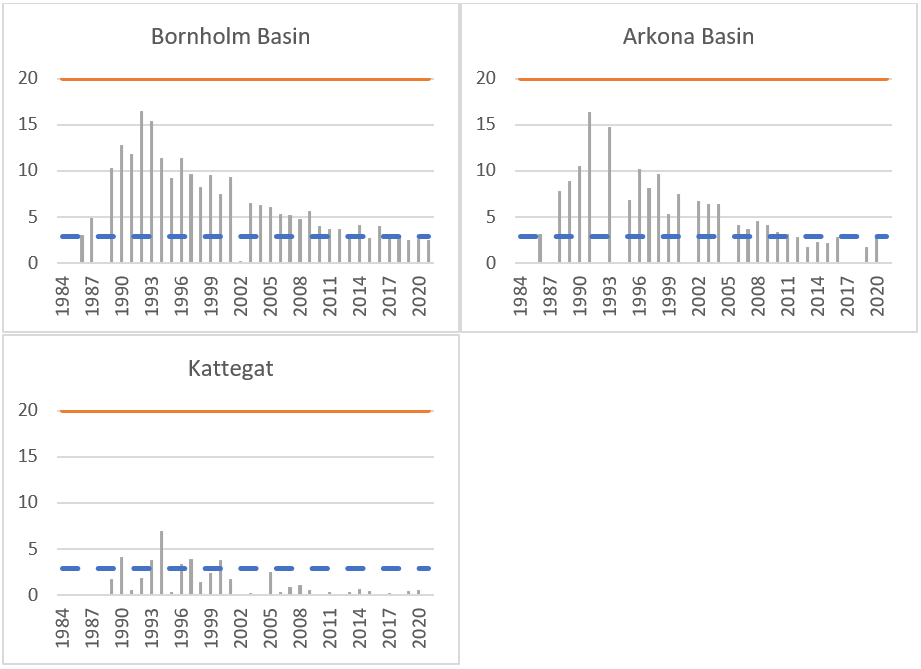
Figure 5. 137Cs concentrations (in Bq kg-1) in flatfish – plaice and flounder (whole fish without head and entrails, or flesh without bones) in 1984–2021, as annual means by sub-basin. The good status boundary: threshold value for fish is equal to 20 Bq kg-1 ww – red line; target value is equal to 2.5 Bq kg-1 ww – blue line.
Surface seawater
Considering the average concentrations of 137Cs calculated for the assessment period 2016-2021 for surface seawaters, all evaluated HELCOM sub-basins achieved good status. The highest average concentrations of 137Cs for this period were found in the Bothnian Sea (20.7 Bq m-3) and Arkona Basin (20.1 Bq m-3). Slightly lower values were calculated for the Western Gotland Basin (19.7 Bq m-3), Northern Baltic Proper (19.1 Bq m-3), and Bornholm Basin (19.1 Bq m‑3). The mean levels between 16.9 and 18.5 were specific to Eastern Gotland Basin, Gdańsk Basin, The Sound, Bay of Mecklenburg and Kiel Bay. The lowest average concentration of 137Cs, equal to 6.7 Bq m-3, was observed in Skagerrak.
In 2021, the concentrations of 137Cs in the seawater were significantly more uniform in their range throughout the different HELCOM sub-basins (Figure 6) as compared to the distribution of 137Cs in surface waters after the Chernobyl accident. As noted in Figure 6, by the end of the 1980s, most of the contaminated areas (the Bothnian Sea and the Gulf of Finland) activities exceeding 500 Bq m-3 were observed, while in the western parts of the Baltic Sea they were close to 100 Bq m-3. In 2021, the highest concentrations were found in the Bothnian Sea (17.8 Bq m-3), Arkona Basin (17.1 Bq m-3) and Northern Baltic Proper (16.2 Bq m-3). Slightly lower values, but still above the target value were found in the Western Gotland Basin (15.6 Bq m‑3), Bornholm Basin (15.4 Bq m‑3), Bay of Mecklenburg (15.4 Bq m‑3) and Great Belt (15.3 Bq m‑3).
Additionally, the mean concentrations of 137Cs reached the pre-Chernobyl level in eight subbasins during 2021: the Bothnian Bay (13.3 Bq m‑3), Gulf of Finland (12.4 Bq m-3), Kiel Bay (13.7 Bq m‑3), Eastern Gotland Basin (14.0 Bq m‑3), Gdańsk Basin (14.0 Bq m‑3), Kattegat (11.5 Bq m‑3), The Sound (11.3 Bq m‑3) and Skagerrak (7.1 Bq m‑3).
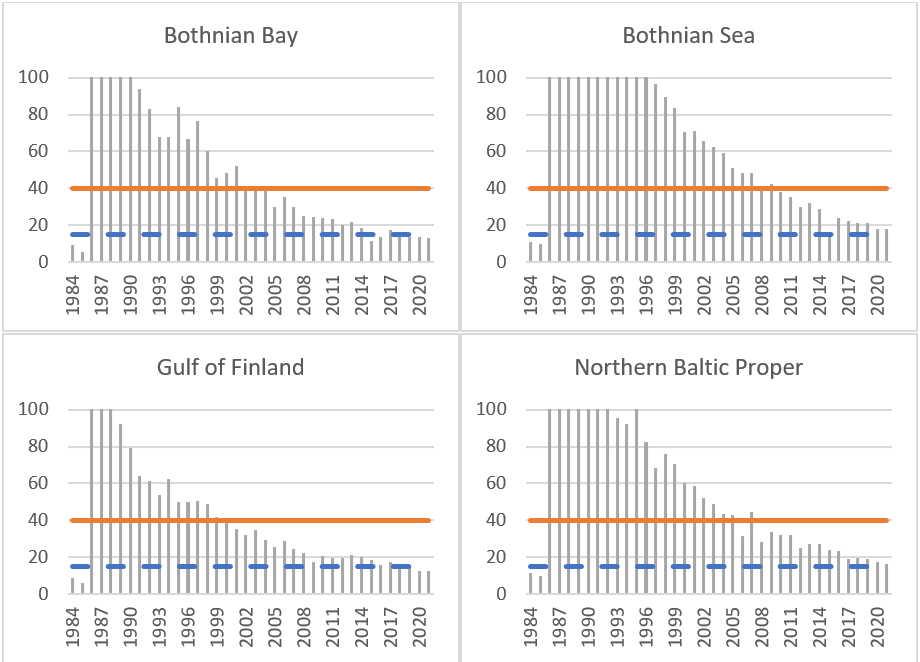
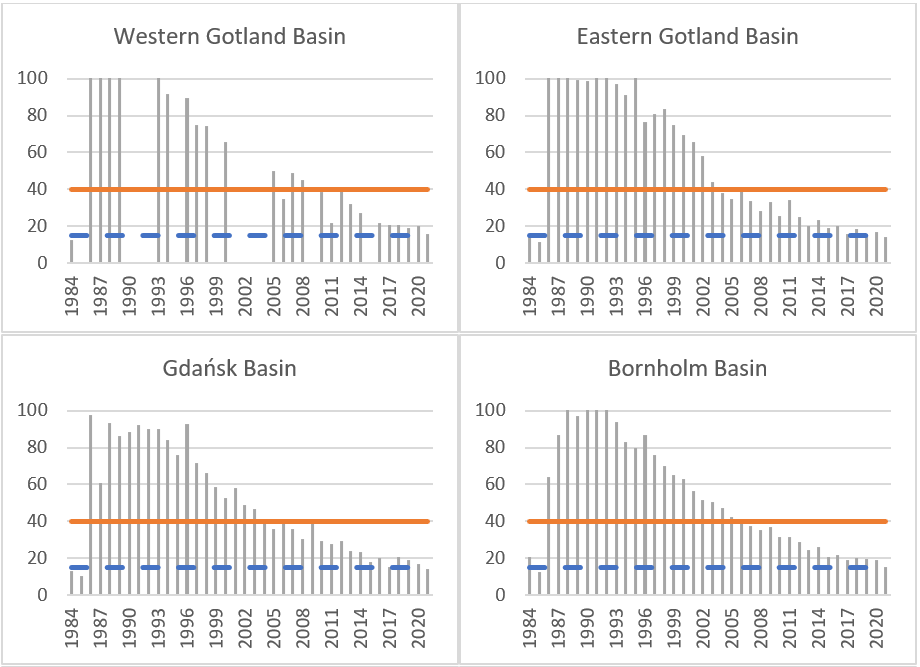
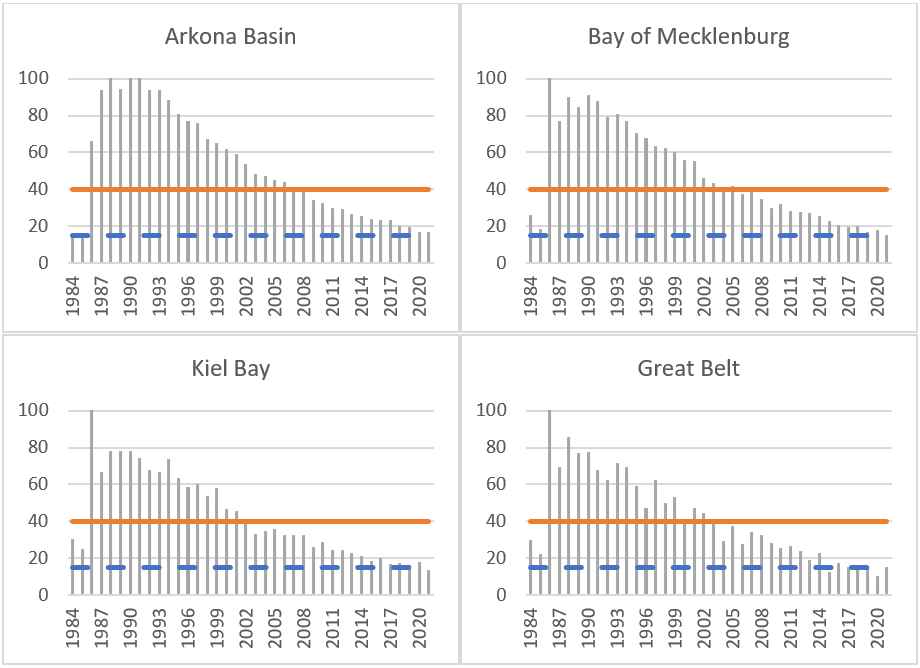
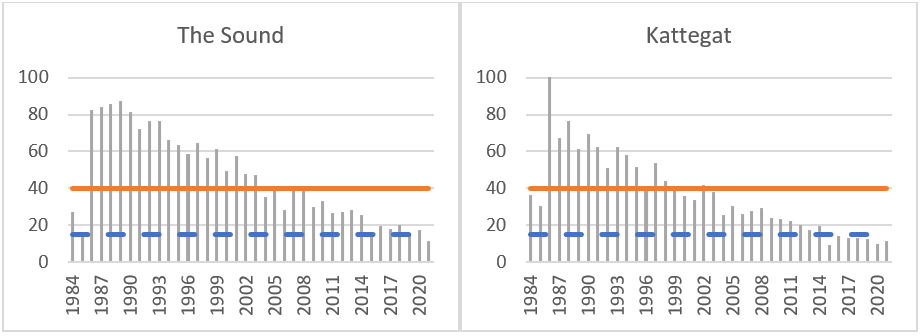
Figure 6. 137Cs concentrations (in Bq m-3) in seawater (sampling depth less than 10 m) in 1984‑2021, as annual mean values by sub-basin. The good status boundary: threshold value for seawater is equal to 40 Bq m-3 – red line; target value is equal to 15 Bq m-3 – blue line.
4.2 Trends
Based on the inventory estimates, the effective half-life of 137Cs in Baltic seawater in the western and southern Baltic Sea (Assessment units 001 to 008) has been 11 years (Figure 8) and between 6 years and 11 years in biota in the period 1986 – 2021 (Figure 7). The effective half-life of a radioactive contaminant is the time required for its concentration to decrease by 50% as a result of physical, chemical and biological processes which are specific of each radionuclide and each environment where they may occur.
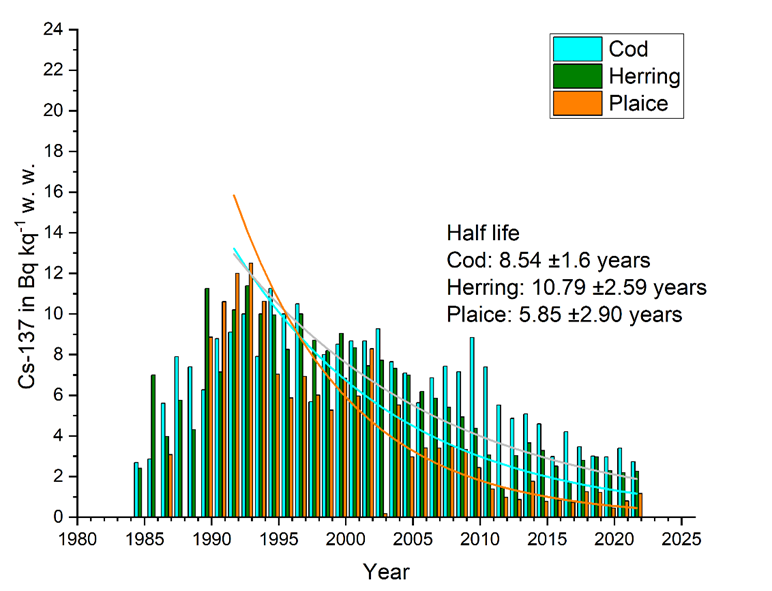
Results figure 7. Annual average specific 137Cs activity in herring, cod and plaice muscle (fillets) collected in the southern and western Baltic Sea (Assessment units 001 to 008) in the period 1984 – 2021. Half-lives were calculated using least-squares fitting exponential decay curves (shown).
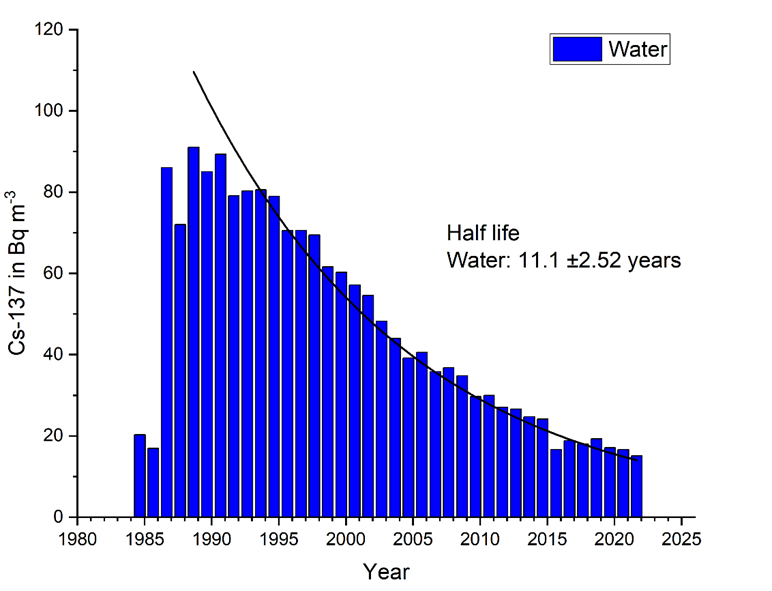
Figure 8. Annual average specific 137Cs activity in seawater collected in the southern and western Baltic Sea (Assessment units 001 to 008) in the period 1984 – 2021. Half-life was calculated using least-squares fitting exponential decay curve.
4.3 Discussion text
The results show that the activity concentrations of 137Cs in biota and seawater reflect good status in all HELCOM assessment units where data was available to carry out an evaluation. A compilation of status for this evaluation (i.e. HOLAS 3, 2016-2021) and a comparison to the previous evaluation (i.e. HOLAS II, 2011-2016 assessment period) is provided below in Table 4.
It is also important to note that the newly approved threshold values applied in this version of the HELCOM indicator report represent a marked change from the threshold values applied in the previous evaluation (i.e. HOLAS II, 2011-2016). In HOLAS II the applied threshold values were those now described in this report as the target values (i.e. pre-Chernobyl levels).
Table 4. Overview of status evaluation outcomes and comparison with prior evaluations. Note that not all parameters (water, herring, and flatfish) are monitored in all areas.
| HELCOM Assessment unit name | Threshold value(s) (overall) achieved/ failed – HOLAS II | Threshold value(s) (overall) achieved/ failed – HOLAS 3 | Distinct trend between current and previous evaluation. | Description of outcomes, if pertinent. |
| Åland Sea | Failed | Achieved | The change in status from fail to achieve between assessment periods is largely due to the application of new threshold values. However, target values (i.e. pre-Chernobyl levels) as used in the previous evaluation are also close to being achieved. This is evidenced by those values being achieved for herring in recent years. | The threshold value is achieved by a substantial margin for all assessed parameters. For herring samples in 2021 the target value is also achieved. |
| Arkona Basin | Failed | Achieved | The change in status from fail to achieve between assessment periods is largely due to the application of new threshold values. However, target values (i.e. pre-Chernobyl levels) as used in the previous evaluation are also close to being achieved. | |
| Northern Baltic Proper | Failed | Achieved | The change in status from fail to achieve between assessment periods is largely due to the application of new threshold values. However, target values (i.e. pre-Chernobyl levels) as used in the previous evaluation are also close to being achieved. | |
| Gdansk Basin | Failed | Achieved | The change in status from fail to achieve between assessment periods is largely due to the application of new threshold values. However, target values (i.e. pre-Chernobyl levels) as used in the previous evaluation are also close to being achieved. This is evidenced by those values being achieved for herring, flatfish and water in recent years. | The threshold value is achieved by a substantial margin for all assessed parameters. For herring, flatfish and water samples in 2021 the target value is also achieved. |
| Great Belt | Failed | Achieved | The change in status from fail to achieve between assessment periods is largely due to the application of new threshold values. However, target values (i.e. pre-Chernobyl levels) as used in the previous evaluation are also close to being achieved. | |
| Bornholm Basin | Failed | Achieved | The change in status from fail to achieve between assessment periods is largely due to the application of new threshold values. However, target values (i.e. pre-Chernobyl levels) as used in the previous evaluation are also close to being achieved. This is evidenced by those values being achieved for flatfish in recent years. | The threshold value is achieved by a substantial margin for all assessed parameters. For flatfish samples in 2021 the target value is also achieved. |
| Bothnian Bay | Failed | Achieved | The change in status from fail to achieve between assessment periods is largely due to the application of new threshold values. However, target values (i.e. pre-Chernobyl levels) as used in the previous evaluation are also close to being achieved. This is evidenced by those values being achieved for water in recent years. | The threshold value is achieved by a substantial margin for all assessed parameters. For water samples in 2021 the target value is also achieved. |
| Bothnian Sea | Failed | Achieved | The change in status from fail to achieve between assessment periods is largely due to the application of new threshold values. However, target values (i.e. pre-Chernobyl levels) as used in the previous evaluation are also close to being achieved. | |
| Eastern Gotland Basin | Failed | Achieved | The change in status from fail to achieve between assessment periods is largely due to the application of new threshold values. However, target values (i.e. pre-Chernobyl levels) as used in the previous evaluation are also close to being achieved. This is evidenced by those values being achieved for herring and water in recent years. | The threshold value is achieved by a substantial margin for all assessed parameters. For herring and water (though not flatfish) samples in 2021 the target value is also achieved. |
| Western Gotland Basin | Failed | Achieved | The change in status from fail to achieve between assessment periods is largely due to the application of new threshold values. However, target values (i.e. pre-Chernobyl levels) as used in the previous evaluation are also close to being achieved. | |
| Gulf of Finland | Failed | Achieved | The change in status from fail to achieve between assessment periods is largely due to the application of new threshold values. However, target values (i.e. pre-Chernobyl levels) as used in the previous evaluation are also close to being achieved. This is evidenced by those values being achieved for water in recent years. | The threshold value is achieved by a substantial margin for all assessed parameters. For water samples in 2021 the target value is also achieved. |
| Kattegat | Failed | Achieved | The change in status from fail to achieve between assessment periods is largely due to the application of new threshold values. However, target values (i.e. pre-Chernobyl levels) as used in the previous evaluation are also close to being achieved. This is evidenced by those values being achieved for herring, flatfish and water in recent years. | The threshold value is achieved by a substantial margin for all assessed parameters. For herring, flatfish and water samples in 2021 the target value is also achieved. |
| The Sound | Failed | Achieved | The change in status from fail to achieve between assessment periods is largely due to the application of new threshold values. However, target values (i.e. pre-Chernobyl levels) as used in the previous evaluation are also close to being achieved. This is evidenced by those values being achieved for water in recent years. | The threshold value is achieved by a substantial margin for all assessed parameters. For water samples in 2021 the target value is also achieved. |
| Gulf of Riga | Failed | Not assessed | Not assessed in current period. | Not assessed in current period. |
| Kiel Bay | Failed | Achieved | The change in status from fail to achieve between assessment periods is largely due to the application of new threshold values. However, target values (i.e. pre-Chernobyl levels) as used in the previous evaluation are also close to being achieved. This is evidenced by those values being achieved for water in recent years. | The threshold value is achieved by a substantial margin for all assessed parameters. For water samples in 2021 the target value is also achieved. |
| Bay of Mecklenburg | Failed | Achieved | The change in status from fail to achieve between assessment periods is largely due to the application of new threshold values. However, target values (i.e. pre-Chernobyl levels) as used in the previous evaluation are also close to being achieved. | |
| The Quark | Failed | Achieved | The change in status from fail to achieve between assessment periods is largely due to the application of new threshold values. However, target values (i.e. pre-Chernobyl levels) as used in the previous evaluation are also close to being achieved. |
Furthermore, according to the aforementioned decay rate, the 137Cs inventory in seawater and biota of the Baltic Sea would reach the pre-Chernobyl levels (250 TBq) by 2025, presuming that the trend would continue and no substantial remobilization of 137Cs from sediments would occur. From the results section, it was possible to observe that, the activity concentrations of 137Cs are currently approaching the pre-Chernobyl levels in most of the sub-basins. In detail, 137Cs in fish and seawater reached their maximum values in the late 1980s and early 1990s. Since then, concentrations of 137Cs in fish and seawater have continued to decrease in all regions of the Baltic Sea.
Apart from this, it should be pointed out that the 137Cs input from the Fukushima fallout (the Fukushima Dai-chii disaster took place in 2011) did not result in detectable increase in 137Cs concentration in seawater and biota of the Baltic Sea (Kanisch and Aust 2013).
5 Confidence
The confidence of the indicator results is high.
Quality assurance is a fundamental part of radioanalytical procedures, and it is needed to confirm the precision and reliability of analytical results . The radiochemical procedures and counting techniques used by laboratories are well tested, up-to-date, and similar to those used by laboratories worldwide. The laboratories from eight countries bordering the Baltic Sea and IAEA MEL have contributed to the two HELCOM-MORS Seawater Intercomparison studies organised in the years 2015 – 2019 and 2020 – 2021. Homogeneous seawater samples were taken twice by Germany and delivered to all laboratories for analysis in each study year in parallel with the monitoring samples. The intercomparison exercises confirmed that the data provided by the MORS group are of very good quality and can be considered comparable. Several laboratories have also participated in the other inter-comparison exercises organized by the IAEA or other bodies.
In addition, spatial and temporal coverage of sampling is high.
6 Drivers, Activities, and Pressures
The development and use of nuclear power for different uses has resulted in the production of a number of man-made radioactive substances worldwide, including 137Cs, and their release into the environment. For example, even the routine operations of nuclear power plants cause small controlled discharges of radioactive substances. Still, accidents at nuclear power plants may release considerable amounts of radioactivity into the environment. Artificial radionuclides of particular concern to mankind and the environment, including 137Cs, are formed by nuclear fission.
The radionuclide 137Cs reached and still reaches the Baltic Sea waters from different sources (such as atmospheric fallout, river discharges, and controlled liquid discharges from working nuclear facilities) and becomes distributed within other compartments of the marine environment. Radioactive fallout from the Chernobyl accident in 1986 is still the dominating source of 137Cs in the Baltic Sea. As for the Baltic Sea, the total collective dose rate of radiation from 137Cs is estimated at 2,600 manSv. From this total, an estimation of two-thirds (1,700 manSv) originated from the Chernobyl fallout, value that stresses that this still the dominating source of radioactivity in the region. As for other sources, an estimation of one quarter (650 manSv) originates from the fallout from atmospheric nuclear weapons testing, 8% (200 manSv) from European reprocessing facilities, and 0.04% (1 manSv) from nuclear installations bordering the Baltic Sea area.
Furthermore, since 1950, the maximum annual equivalent dose to individuals from any critical group in the Baltic Sea area due to 137Cs is estimated at 0.2 mSv y-1. This value is lower than the doses that humans receive from natural radionuclides in foodstuffs, which are e.g. 0.215- 0.521 mSv in Germany (BfS 2014), and much lower than the dose limit of 1 mSv y-1 set for the exposure of members of the public from man-made sources in the IAEA – International Basic Safety Standards (IAEA (1996)).
In this sense, considering the uncertainties involved in the evaluation, it is unlikely that any individual has been exposed from marine pathways at a level above this dose limit. Doses to man due to liquid discharges from nuclear power plants in routine operation into the Baltic Sea area are estimated at or below the levels mentioned in the Basic Safety Standards to be of no regulatory concern (individual dose rate of 10 µSv y-1 and collective dose of 1 manSv). It should be noted that the assumptions made throughout the evaluation were chosen to be realistic and not conservative. Consequently, this also applies to the estimated radiation doses to man.
All things considered, it is important to highlight that dose rates and doses from natural radioactivity have been dominant except for the year 1986 when the individual dose rates from the Chernobyl fallout in some regions of the Baltic Sea approached those from natural radioactivity. Since then, improvements in the safety of nuclear power plants have reduced the risk of the reoccurrence of such accidents.
Drivers behind potential sources of radioactive substances may relate for example to changes in population and changes the need for energy production. Considering the need to also adjust energy production and limit the impacts of climate change the use of nuclear power may also become more prominent. These drivers in themselves do not directly infer impacts on the environment as informed management, good regulation and relevant prevention or mitigation measures can clearly counteract the risk of detrimental environmental release.
Table 5. Brief summary of relevant pressures and activities with relevance to the indicator.
| | General | MSFD Annex III, Table 2a |
| Strong link | Substances, litter and energy
– Input of other substances (e.g. synthetic substances, non-synthetic substances, radionuclides) – diffuse sources, point sources, atmospheric deposition, acute events. |
|
| Weak link |
7 Climate change and other factors
Climate change may impact the distribution and levels of radionuclides, including 137Cs, in the marine environment. Among the direct parameters of climate change, the fate of 137Cs in the Baltic Sea environment may be affected by the following:
1. Seawater temperature – an increase in water temperature may affect the metabolism of marine organisms and increase the efficiency of bioaccumulation of radionuclides.
2. Large-scale atmospheric circulation – it can affect the transport of pollutants, including radionuclides, over long distances and thus influence the amount of deposition to the waters of the Baltic Sea, especially in accidental situations.
3. Salinity and salt waters inflows – the exchange of waters with the North Sea is important for shaping radionuclide levels in the Baltic Sea; two main nuclear fuel reprocessing plants are located in Sellafield (Great Britain) and La Hague (France).
4. Stratification – directly influences the radionuclides concentration distribution in the water column.
5. Precipitation – changes in the precipitation regime may affect the amount of atmospheric radionuclide deposition to the Baltic Sea.
6. River run-off – may be an important source of radioactive substances entering the Baltic Sea, especially in the event of contamination of the catchment area; increasing the inflow in flood situations increases the inflow of radionuclides.
7. Carbonate chemistry – changes in the pH of the aquatic environment may affect the metabolism of organisms and thus the efficiency of bioaccumulation of radionuclides.
8. Waves – changing the wave regime may affect the radionuclide distribution in seawater.
9. Sediment transportation – due to significant amounts of radionuclides deposited in bottom sediments, dynamics at the bottom and transport of sediments may lead to secondary radionuclide release.
8 Conclusions
The radionuclide 137Cs reached and still reaches the Baltic Sea waters from different sources (such as atmospheric fallout, river discharges, and controlled liquid discharges from working nuclear facilities) and ends up distributed within other compartments of the marine environment. Nonetheless, the radioactive fallout from the Chernobyl accident in 1986 is still the dominating source of 137Cs in the Baltic Sea.
The indicator evaluation shows that the levels of 137Cs that reached the Baltic Sea environment due to the Chernobyl accident have decreased significantly and in the current evaluation is at levels below the threshold value, thus indicating Good Environmental Status. Furthermore, in the latest years of the evaluation several monitoring areas have values that are also below the target level (i.e. now also achieving pre-Chernobyl levels).
8.1 Future work or improvements needed
The current annual sampling of biota and seawater is considered to be of adequate frequency for the core indicator. The biota monitoring in each sub-basin depends on the availability of certain species during the time of monitoring cruises and cannot be secured at all times. As well as ensuring a certain level of regular spatial and temporal monitoring, even when good status is achieved to maintain an overview of the situation, there may be needs to further explore gaps such as the few areas where no evaluation was possible or where not all monitoring matrices (e.g. water and fish species) are covered. Such improvements would provide a stronger evaluation and safeguard against future impacts on the marine environment. In the future, once an EU food limit value is agreed upon and implemented, then it would be relevant to also examine this aspect in relation to this indicator.
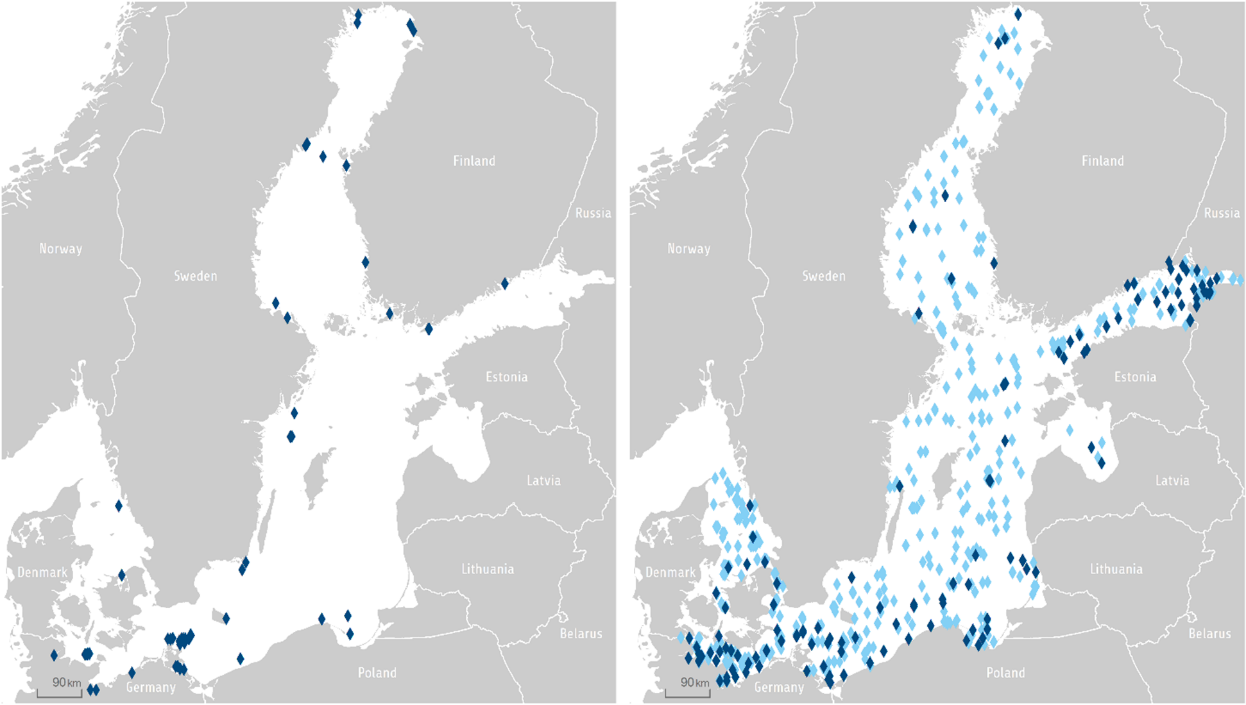
Figure 9. Monitoring stations for biota (left) and seawater (right) used to assess trends in radioactive 137Cs. Dark blue symbols indicate data series incorporated into the specific assessment period 2016-2021 and pale blue symbols indicate those stations also within the overall assessment period presented. HELCOM scale 2 assessment units are used for this indicator.
Gaps in monitoring in relation to the HELCOM assessment units are defined in HELCOM Monitoring and Assessment Strategy Annex 4: 137Cs in seawater is sampled in all HELCOM sub-basins except for the Quark and Åland Sea.
Currently, the coverage of 137Cs in herring extends to most of the HELCOM sub-basins. There are, however, no samples from the Northern Baltic Proper, Gulf of Riga, The Sound, or the Great Belt. Also, the northern part of the Eastern Gotland Basin is not covered by annual samplings. Furthermore, reduced stocks of herring and therewith reduced catch limits or even fishing bans may also affect the monitoring of radioactive substances.
The radionuclide 137Cs in flatfish is sampled only in the most relevant southern Baltic Sea sub-basins.
9 Methodology
The data for the concentrations of 137Cs in the biota and seawater used in the analysis of the status of this core indicator are originated from the monitoring programmes of the Baltic Sea, further description on monitoring and reporting requirements can be found in section 9.2.
The methodology for deriving the threshold values is outlined in section 3.1.
The pre-Chernobyl values used to derive the target value have been calculated based on the data in the HELCOM MORS database. The data used for defining the target value for 137Cs concentrations in herring, flatfish (plaice and flounder) and surface waters were collected between 1984 and 1985. The mean pre-Chernobyl 137Cs concentrations have been used as target values.
The evaluation of whether the good status is achieved is carried out by calculating the mean value for all samples during the assessment period 2016 – 2021 in each assessment unit and comparing it against the threshold values.
The methodology and basis of the indicator evaluation is provided below.
9.1 Scale of assessment
This core indicator evaluates the activity concentrations of 137Cs using HELCOM assessment unit scale 2 (division of the Baltic Sea into 17 sub-basins). The assessment units are defined in the HELCOM Monitoring and Assessment Strategy Annex 4.
9.2 Methodology applied
The overall status of the Baltic Sea is carried out by the one-out all-out principle from the results for each assessment unit. This means that the worst classification drives the result for the whole Baltic Sea.
9.3 Monitoring and reporting requirements
Monitoring methodology
HELCOM common monitoring relevant to radioactivity in the marine environment is documented on a general level in the HELCOM Monitoring Manual under the HELCOM Monitoring Programme: Contaminants in biota and HELCOM Monitoring Programme: Contaminants in water.
Monitoring methodology including methods, frequency and stations is described in detail in MORS Guidelines (HELCOM Recommendation 26/3).
Over ten laboratories from the nine countries bordering the Baltic Sea have contributed to the monitoring programmes of the Baltic Sea by analysing radionuclides in marine samples. The various analytical methods used in the different laboratories are summarised in the HELCOM thematic assessment: Radioactivity in the Baltic Sea, 1999–2006 (HELCOM (2009)).
Current monitoring
The monitoring activities relevant to the indicator that are currently carried out by HELCOM Contracting Parties are described in the HELCOM Monitoring Manual, and the relevant Monitoring Concept Tables can be found in the following documents.
HELCOM Monitoring Programme topic Concentrations of contaminants: Contaminants in biota
HELCOM Monitoring Programme topic Concentrations of contaminants: Contaminants in water
Stations are described in detail in the MORS Guidelines (HELCOM Recommendation 26/3) and in the HELCOM Map and Data Service.
10 Data
The data and resulting data products (e.g. tables, figures and maps) available on the indicator web page can be used freely given that it is used appropriately and the source is cited.
Result: Radioactive substances – Caesium-137 in water and biota
Data: Radioactive substances – Caesium-137 in water
Data: Radioactive substances – Caesium-137 in biota
Data source: HELCOM MORS Database.
Description of data: Herring and seawater data cover most of the Baltic Sea, but flatfish covers only southern parts of the Baltic Sea. The data are based on 137Cs concentrations in a) herring (Clupea harengus L.), b) flounder (Platichthys flesus L.) and plaice (Pleuronectes platessa L.) and c) surface seawater (samples 0–10 m). Analyses have been done either in round fish (without head and entrails) or filets (herring), and for plaice and flounder from filets only. Concentrations (Bq kg-1) have been calculated per wet weight of the samples. Seawater concentrations (Bq m-3) have been analysed in surface (0–10 m) water samples. Data of each matrix (herring, plaice and flounder and seawater) have been averaged by sub-basin and by year.
The data is collected by national authorities and reported annually to the HELCOM MORS Database. In addition to national quality assurance procedures, manual quality assurance is applied to the reported data and data entries are verified annually by the HELCOM MORS Expert Group.
11 Contributors
Tamara Zalewska, Institute of Meteorology and Water Management – National Research Institute, Poland
Marc-Oliver Aust, Thünen Institute of Fisheries Ecology, Germany
HELCOM Monitoring of Radioactive Substances Expert Group (HELCOM MORS EG)
HELCOM Secretariat: Jannica Haldin, Joni Kaitaranta, Owen Rowe
12 Archive
This version of the HELCOM core indicator report was published in April 2023:
The current version of this indicator (including as a PDF) can be found on the HELCOM indicator web page.
Earlier versions of the core indicator:
Radioactive substances HELCOM core indicator 2018 (pdf)
HOLAS II component – Core indicator report – web-based version July 2017 (pdf)
Radioactive substances-HELCOM core indicator report 2015-extended version (pdf)
13 References
European Commission (2008) Directive 2008/56/EC of the European Parliament and of the Council of 17 June 2008 establishing a framework for community action in the field of marine environmental policy (Marine Strategy Framework Directive). Off. J. Eur. Union L 164: 19-40.
European Commission (2010a) Marine Strategy Framework Directive, Task Group 9: Contaminants in fish and other seafood. EC JRC Scientific and Technical report.
European Commission (2010b) Commission Decision of 1 September 2010 on criteria and methodological standards on good environmental status of marine waters (2010/477/EU). Off. J. Eur. Union L 232: 12-24.
European Commission (2012) Commission implementing regulation (EU) No 996/2012 of 26 October 2012 imposing special conditions governing the import of feed and food originating in or consigned from Japan following the accident at the Fukushima nuclear power station and repealing Implementing Regulation (EU) No 284/2012.
European Commission (2013) Council Directive 2013/59/Euratom of 5 December 2013 laying down basic safety standards for protection against the dangers arising from exposure to ionising radiation, and repealing Directives 89/618/Euratom, 90/641/Euratom, 96/29/Euratom, 97/43/Euratom and 2003/122/Euratom. Available Online at: https://eur-lex.europa.eu/legal-content/EN/ALL/?uri=CELEX:32013L0059 [last verified: 15.05.2020]
Federal Office for Radiation Protection (BfS) (2014) Contribution of food to radiation dose. (In German). Available Online at: http://www.bfs.de/de/ion/anthropg/lebensmittel/dosisbeitrag.html.
Guillen J., Natale F., Carvalho N., Casey J., Hofherr J., Druon J.-N., Fiore G., Gibin M., Zanzi A., Martinsohn J. Th. (2019): Global seafood consumption footprint. Ambio 48/2, 111-122
HELCOM (2009) Radioactivity in the Baltic Sea, 1999–2006. HELCOM thematic assessment. Balt. Sea Environ. Proc. No. 117. 60 pp.
HELCOM (2021): HELCOM Baltic Sea Action Plan– 2021 update
IAEA (1996) International Basic Safety Standards for Protection Against Ionizing Radiation and for the Safety of Radiation Sources. Safety Series No. 115. IAEA, Vienna.
IAEA (2001) – Safety Report Series No. 19: Generic models for use in assessing the impact of discharges of radioactive substances to the environment. — Vienna: International Atomic Energy Agency, 2001. 229 pp., ISSN 1020–6450, ISBN 92-0-100501-6
IAEA (2005) Worldwide Marine Radioactivity Studies -WOMARS, Radionuclides Levels in Oceans and Sea, IAEA-TECDOC-1429. ISBN 92-0-114904-2. 125 pp.
IAEA (2014) – General Safety Requirements (GSR) Part 3: Radiation Protection and Safety of Radiation Sources: International Basic Safety Standards, Vienna: International Atomic Energy Agency, 2014, 471pp. ISBN 978–92–0–135310–8
IAEA (2015) – TECDOC 1759: Determining the suitability of materials for disposal at sea under the London Convention 1972 and London Protocol 1996: a radiological assessment procedure. — Vienna: International Atomic Energy Agency, 2015. 100 pp., ISBN 978–92–0–100215–0
ICRP (2008) Environmental protection – The concept and use of reference animals and plants. Annals of the ICRP 108: 4-6.
ICRP (2012) Publication 119: Compendium of Dose Coefficients based on ICRP Publication 60. Annals of the ICRP 41 supplement 1. 132 pp. ISBN 978-1-4557-5430-4
Kanisch, G., Aust, M.-O. (2013) Does the Fukushima NPP disaster affect the caesium activity of North Atlantic Ocean fish? Biogeosciences 10: 5399–5410.
Nielsen, S.P., Bengston, P., Bojanowski, R., Hagel, P., Herrmann, J., Ilus, E., Jakobson, E., Motiejunas, S., Panteleev, Y., Skujina, A., Suplinska, M. (1999) The radiological exposure of man from radioactivity in the Baltic Sea. Sci. Tot. Environ. 237/238: 133-141.
Zalewska, T., Suplińska, M. (2013) Fish pollution with anthropogenic 137Cs in the southern Baltic Sea. Chemosphere 90: 1760-1766.
14 Other relevant resources
HELCOM (2003) Radioactivity in the Baltic Sea 1992–1998. Balt. Sea Environ. Proc. No. 85. 102 pp.
HELCOM (1995) Radioactivity in the Baltic Sea 1984–1991. Balt. Sea Environ. Proc. No. 61. 182 pp.
HELCOM (1989) Three years observations of the levels of some radionuclides in the Baltic Sea after the Chernobyl Accident. Balt. Sea Environ. Proc. No. 31. 155 pp.
Herrmann, J., Kanisch, G. (2010) Concentrations of the artificial radionuclide caesium-137 in Baltic Sea fish and surface waters. HELCOM Indicator Fact Sheets 2010.
Ilus, E., Sjöblom, K.L., Ikäheimonen, T.K., Saxén, R., Klemola, S. (1993) Monitoring of radionuclides in the Barltic Sea in 1989–1990. STUK-A103, Helsinki. 35 pp.
Outola, I. (2010) Total amounts of the artificial radionuclide caesium-137 in Baltic Sea sediments. HELCOM Indicator Fact Sheets 2010.
Vartti, V.-P. (2010) Liquid discharges of Cs-137, Sr-90 and Co-60 into the Baltic Sea from local nuclear installations. HELCOM Indicator Fact Sheets 2010.
